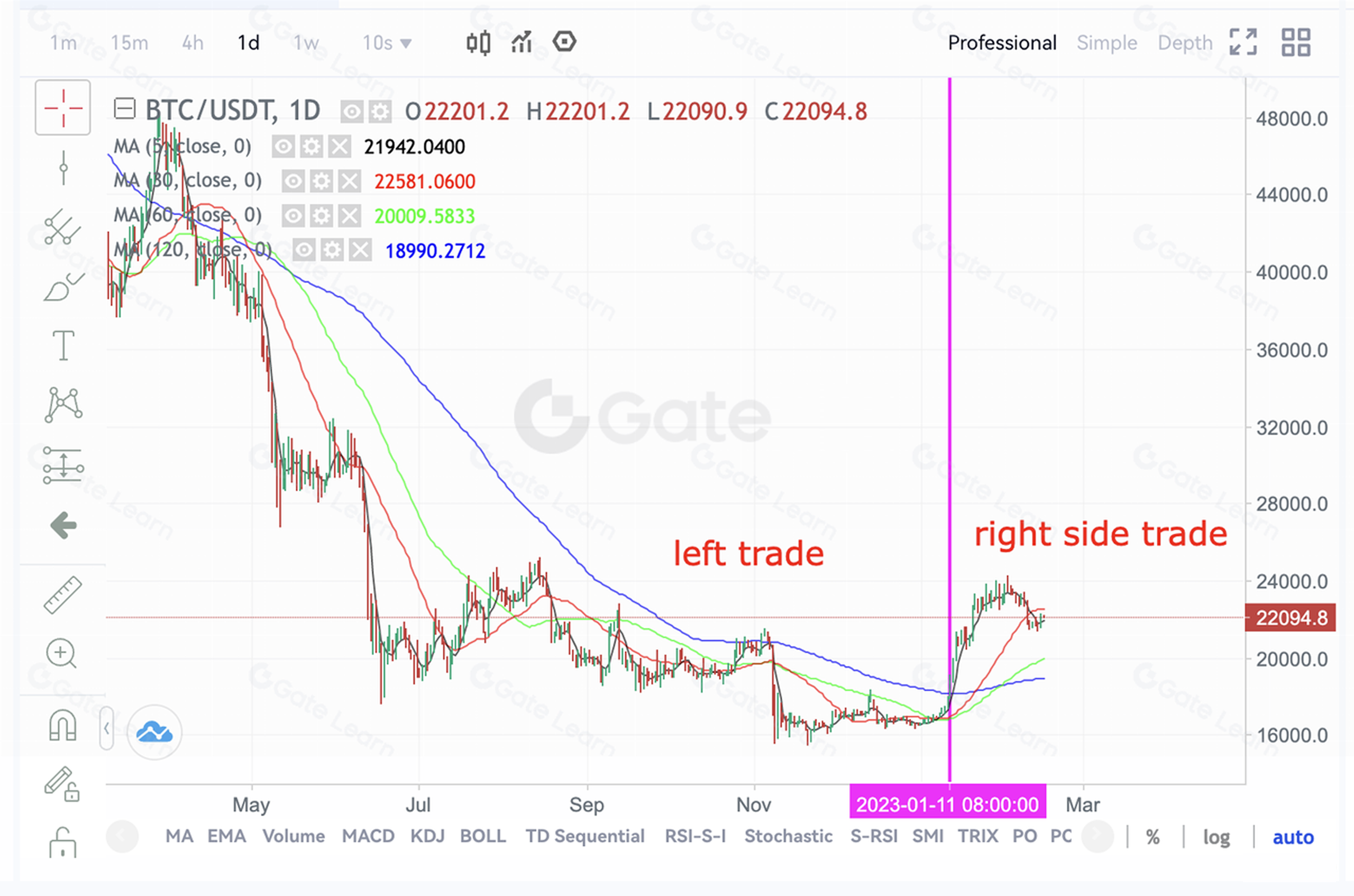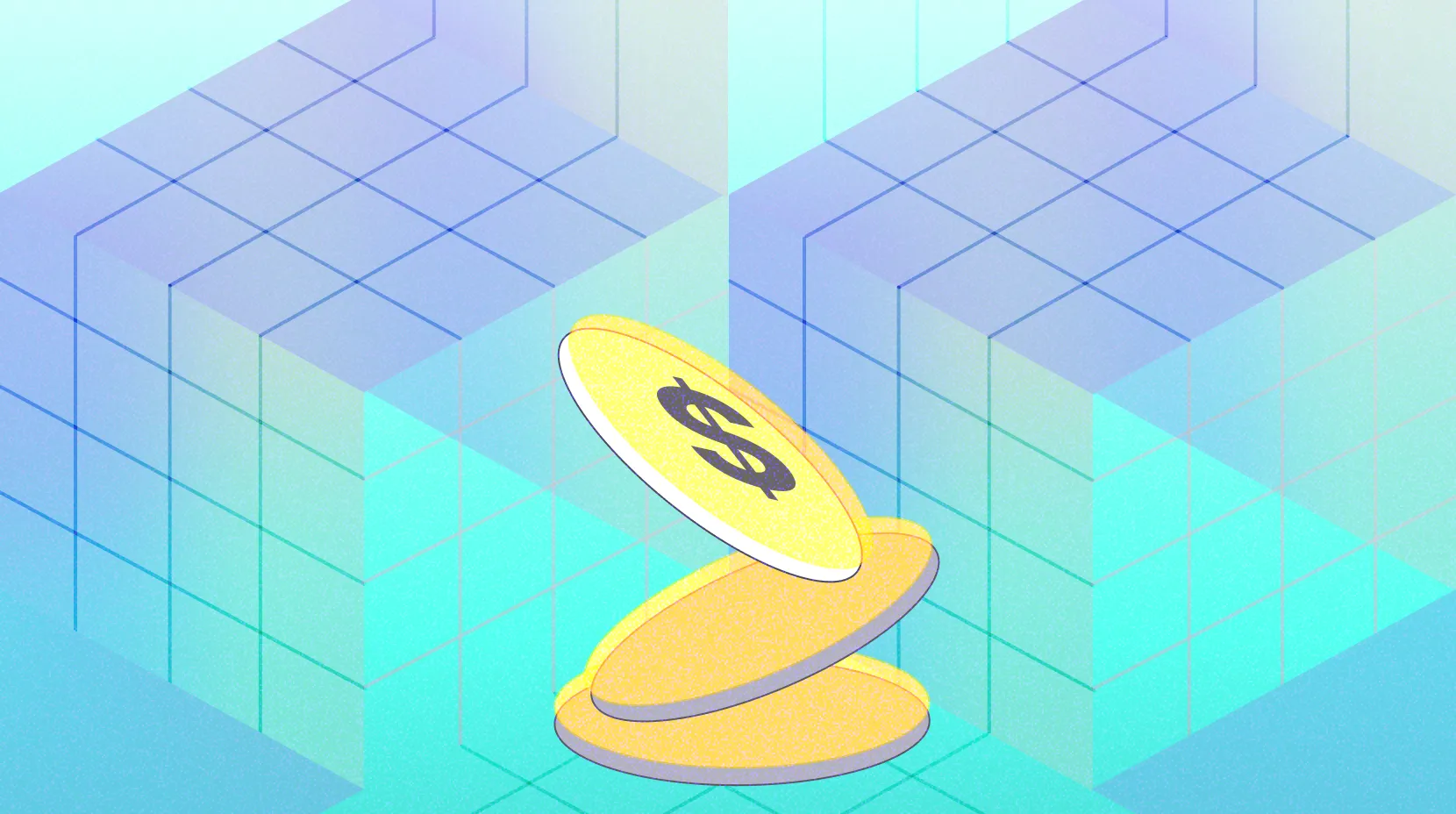Apa yang dimaksud dengan perdagangan sisi kiri dan sisi kanan
Kursus “Gate Learn Futures” tingkat menengah ini membahas konsep dan penggunaan beragam indikator teknikal, seperti grafik candlestick, pola analisis teknikal, rata-rata bergerak, serta garis tren. Setelah bab sebelumnya yang mengulas pengenalan pola tren, pada bab ini kami menjelaskan konsep left-side trading (perdagangan sisi kiri) dan right-side trading (perdagangan sisi kanan). Kami akan membahas persamaan dan perbedaan kedua jenis perdagangan tersebut. Selain itu, kami juga menyajikan skenario terbaik untuk penerapannya.
Apa itu left-side trading dan right-side trading?
- Left-side trading
Left-side trading adalah strategi di mana investor membeli aset sebelum harga mencapai titik terendah atau menjualnya sebelum harga mencapai puncak. Singkatnya, investor membeli aset sebelum pola dasar terbentuk pada grafik K-line, yakni membeli di sisi kiri dasar garis, atau menjual aset sebelum pola puncak terbentuk, yaitu menjual di sisi kiri puncak garis. Meskipun left-side trading dilakukan sebelum harga benar-benar menyentuh dasar atau puncak, peluang harga untuk berbalik arah cenderung lebih kecil. Biasanya, trading melawan tren terjadi di akhir pasar bullish, saat trader secara agresif menambah posisi. Setelahnya, pasar bearish muncul dan menjebak investor yang kurang beruntung. Ketika pasar mulai pulih, investor yang lama terjebak membeli di harga tinggi dan menjual di harga rendah pada awal tren bullish, lalu mulai mengambil posisi short di pertengahan hingga akhir pasar bullish. Bagi trader yang mengandalkan analisis teknikal, trading melawan tren menyebabkan kerugian utama. Singkatnya, left-side trading didasarkan pada prediksi, sedangkan right-side trading mengikuti tren yang terbentuk. - Right-side trading
Right-side trading berarti trader membeli aset dengan keyakinan bahwa harga cryptocurrency sudah mencapai titik terendah dalam periode tertentu, atau menjual aset dengan asumsi harga telah mencapai puncak.

Perbedaan dan Keterkaitan
- Perbedaan
- Left-side trading didasarkan pada prediksi subjektif trader terhadap tren pasar, sedangkan right-side trading adalah respons objektif terhadap perubahan harga yang nyata.
- Left-side trading menggunakan pola pikir berlawanan, sedangkan right-side trading menggunakan pola pikir yang sejalan dengan arah pasar.
- Pada left-side trading, trader dengan strategi left-side trading mengambil keputusan dengan harapan harga bergerak berlawanan arah dari kondisi saat ini. Sementara pada right-side trading, trader dengan strategi right-side trading mengantisipasi harga bergerak sesuai arah pasar.
- Esensi left-side trading adalah “beli saat harga rendah, jual saat harga tinggi”. Trader membeli aset di harga rendah dan menjualnya ketika harga mendekati puncak untuk memperoleh keuntungan. Right-side trading berarti menambah posisi saat harga naik dan menjual aset setelah harga mencapai puncak dan mulai turun. Dengan demikian, trading mengikuti tren menggunakan logika “beli saat harga tinggi, jual saat harga rendah”.
- Left-side trading lebih cocok untuk investor bermodal besar yang memiliki ketahanan finansial, sedangkan right-side trading lebih tepat untuk investor skala kecil dan menengah.
- Kesalahan umum dalam left-side trading adalah membeli koin di tengah penyesuaian pasar bearish dan menjualnya di tengah penyesuaian pasar bullish. Pada right-side trading, trader akan mengalami kerugian jika membeli aset saat terjadi rally pada garis bulanan di pasar bearish dan menjualnya pada penyesuaian pasar bullish.
- Secara potensi keuntungan, left-side trading bisa lebih menguntungkan dibanding right-side trading, namun risikonya juga lebih besar.
- Trader dengan strategi left-side trading yakin harga saat ini berada di titik dasar atau puncak, sementara trader dengan strategi right-side trading mengasumsikan harga sudah melewati titik terendah atau tertinggi.
- Persamaan
- Dalam left-side trading maupun right-side trading, trader harus memegang prinsip utama: jangan pernah trading melawan arah tren.
- Kedua metode trading menggunakan aturan analisis tren yang sama. Secara garis besar, perbedaan keduanya hanya terletak pada timing beli atau jual aset. Selain itu, penggunaan indikator trading dan metode analisis tren tidak membedakan kedua pendekatan.
- Kesalahpahaman terkait left-side trading
- Left-side trading merupakan trading melawan tren. Praktik ini dilakukan berdasarkan prediksi arah pasar kripto, sehingga trader harus bertindak dengan perkiraan bahwa harga akan berubah pada momen dan posisi krusial.
- Left-side trading sering dianggap sebagai investasi nilai. Investasi nilai dilakukan berdasarkan analisis fundamental pasar, di mana investor menambah posisi di titik harga rendah. Semakin rendah harga, semakin besar posisi yang dibuka. Namun, timing left-side trading ditentukan lewat analisis teknikal, sehingga investor harus segera menjual aset dan membatasi kerugian bila prediksi tidak sesuai.
Aplikasi
- Right-side trading tidak ideal digunakan bila trader ingin mengambil peluang rally di pasar bearish. Bahkan pada rally di garis bulanan, kasus paling umum adalah membeli tinggi dan menjual rendah.
- Kedua metode trading sebaiknya tidak digabungkan dalam satu strategi.
- Sinyal tren lain perlu digunakan sebagai pelengkap untuk meningkatkan peluang kemenangan.
Siklus trading dan manajemen posisi
1. Alasan manajemen posisi diperlukan:
- a. Mengurangi kerugian sekaligus meningkatkan profit;
- b. Memudahkan eksekusi transaksi beli dan jual aset.
- c. Membantu menjaga kestabilan emosi dan menghindari kerugian yang makin besar.
Prinsipnya, seluruh aset diinvestasikan saat pasar bullish, sementara posisi short diambil pada saat di luar pasar bullish. Berikut penerapan spesifik dan aturan manajemen posisi:
2. Dalam tren naik jangka panjang, jika harga cryptocurrency menembus garis tren turun jangka pendek atau menengah, itu menjadi sinyal beli dan penambahan posisi. Jika harga turun menembus garis tren naik jangka pendek atau menengah, itu menjadi sinyal untuk mengurangi posisi. Jika harga bergerak di atas garis tren naik jangka panjang, sinyalnya adalah mempertahankan posisi.
3. Bila harga turun menembus garis tren naik jangka panjang, itu menjadi sinyal untuk menutup posisi. Jika harga bergerak di bawah garis tren turun jangka panjang, sinyalnya adalah mengambil posisi short.
4. Jika harga menembus garis tren turun jangka panjang lalu mendapat dukungan dari tren naik jangka menengah, itu sinyal beli; jika harga cryptocurrency turun menembus garis tren naik jangka menengah, itu menjadi sinyal menutup posisi.

Mengandalkan satu metode analisis teknikal saja tidak cukup untuk sepenuhnya menekan risiko atau memaksimalkan keuntungan. Dalam praktiknya, trader perlu memadukan berbagai metode analisis teknikal tren sebagai pelengkap demi manajemen risiko yang lebih optimal.
Ringkasan
Left-side trading dan right-side trading adalah dua gaya trading berbeda dengan logika dan pendekatan yang sangat kontras. Intinya, keduanya mengharuskan trader untuk memprediksi pergerakan tren melalui analisis teknikal, lalu melakukan trading berdasarkan prediksi tersebut. Metode ini membantu pemula di pasar kripto dalam menentukan waktu optimal untuk melakukan transaksi beli atau jual aset, khususnya jika dikombinasikan dengan berbagai metode analisis teknikal lainnya.
Daftar di platform Gate Futures untuk mulai trading!
Disclaimer
Perhatian: Artikel ini hanya untuk tujuan informasi dan bukan merupakan saran investasi. Gate tidak bertanggung jawab atas keputusan investasi yang diambil oleh pengguna. Seluruh informasi terkait analisis teknikal, penilaian pasar, teknik trading, maupun sharing dari trader tidak boleh dijadikan acuan investasi. Setiap investasi mengandung risiko dan ketidakpastian, dan artikel ini tidak menjamin hasil atau return atas investasi apa pun.





